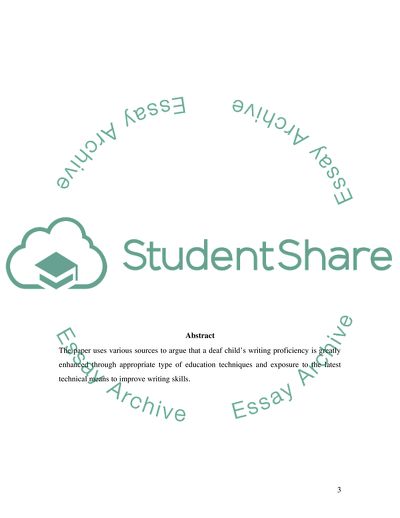Cite this document
(Education and a Deaf Childs Writing Proficiency Research Paper, n.d.)
Education and a Deaf Childs Writing Proficiency Research Paper. Retrieved from https://studentshare.org/education/1763039-to-what-extent-is-education-the-most-significant-factor-upon-a-deaf-childs-writing-proficiency-support-your-argument-using-examples-from-the-writing-samples-you-have-been-given-you-can-also-use-other-samples-that-have-been-published-in-academic-book
Education and a Deaf Childs Writing Proficiency Research Paper. Retrieved from https://studentshare.org/education/1763039-to-what-extent-is-education-the-most-significant-factor-upon-a-deaf-childs-writing-proficiency-support-your-argument-using-examples-from-the-writing-samples-you-have-been-given-you-can-also-use-other-samples-that-have-been-published-in-academic-book
(Education and a Deaf Childs Writing Proficiency Research Paper)
Education and a Deaf Childs Writing Proficiency Research Paper. https://studentshare.org/education/1763039-to-what-extent-is-education-the-most-significant-factor-upon-a-deaf-childs-writing-proficiency-support-your-argument-using-examples-from-the-writing-samples-you-have-been-given-you-can-also-use-other-samples-that-have-been-published-in-academic-book.
Education and a Deaf Childs Writing Proficiency Research Paper. https://studentshare.org/education/1763039-to-what-extent-is-education-the-most-significant-factor-upon-a-deaf-childs-writing-proficiency-support-your-argument-using-examples-from-the-writing-samples-you-have-been-given-you-can-also-use-other-samples-that-have-been-published-in-academic-book.
“Education and a Deaf Childs Writing Proficiency Research Paper”. https://studentshare.org/education/1763039-to-what-extent-is-education-the-most-significant-factor-upon-a-deaf-childs-writing-proficiency-support-your-argument-using-examples-from-the-writing-samples-you-have-been-given-you-can-also-use-other-samples-that-have-been-published-in-academic-book.


